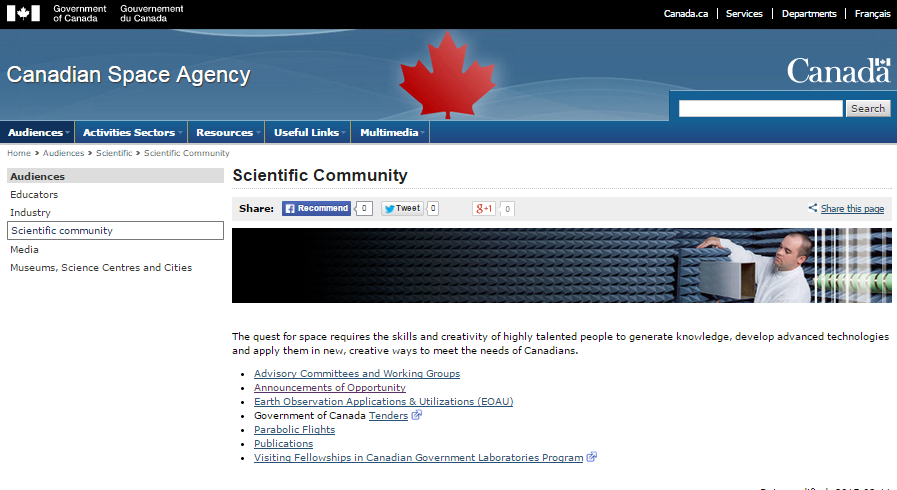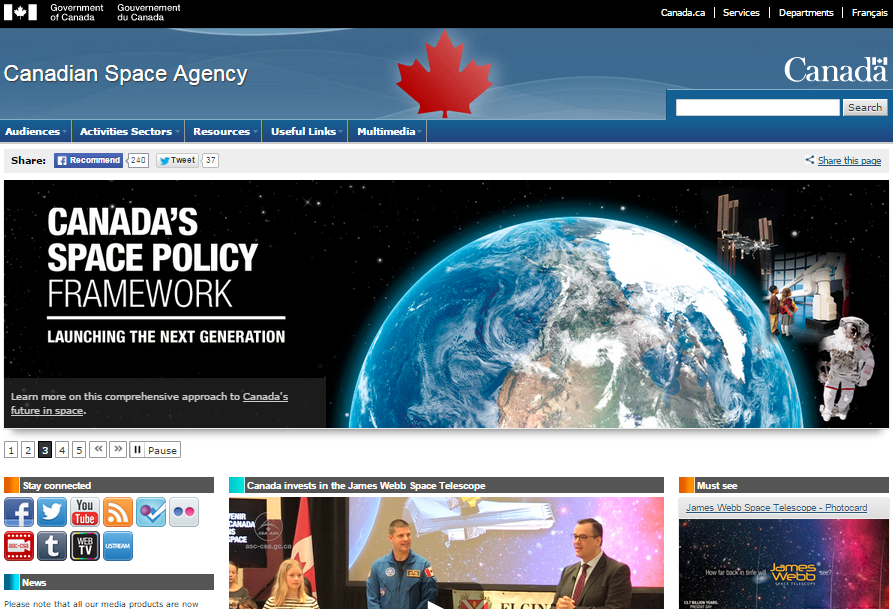By Glen Strom
The Canadian Space Agency’s (CSA) website isn't just for kids’ school projects or the casual space fan. Educators, space business people, scientists, engineers, and members of the media will find resources that are useful to their work.
In part one of this series, we looked at the CSA resources available for educators and business. This week, we'll take a look at CSA resources relating to the scientific community, media resources, and museums, science centres and cities that host CSA exhibits.
On of the challenges to the CSA over the last few years, at least since the publication of the 2012 Federal Review of Aerospace and Space Programs and Policies (or "Emerson Report"), which was most recently discussed in the February 27th, 2014 post on "The "Casablanca" of Space Conferences," has been the role of the CSA in the scientific community.
 Because of this, the Scientific Community section of the CSA website might not be up-to-date and some of the Advisory Committees and Working Groups may not be active.
Because of this, the Scientific Community section of the CSA website might not be up-to-date and some of the Advisory Committees and Working Groups may not be active.
However, this is what the CSA website currently lists.
The main government news site has all of the CSA press releases.
The CSA website isn’t just for the kids or the casual space fan. It has a lot of useful information that can help professionals educate, get new business, get funding for research, or get career-building experience.
_____________________________________________________
Glen Strom is a freelance writer and editor with a background in business and technical writing. He's also the editor of The Gazette Weekly, the newsletter of the Canadian Space Society.
The Canadian Space Agency’s (CSA) website isn't just for kids’ school projects or the casual space fan. Educators, space business people, scientists, engineers, and members of the media will find resources that are useful to their work.
 |
| CSA website screenshot taken April 5th, 2015. This section of the CSA website contains documents relating to its broader mandate within the Canadian government. The CSA was established in March 1989 under the Canadian Space Agency Act and works with the Department of National Defense (DND) on military space-focused activities and the Department of Foreign Affairs and International Trade (DFAIT) on activities related to international co-operation and technology transfer. As per the 2012 Federal Review of Aerospace and Space Programs and Policies (or "Emerson Report"), the CSA acts "as a technical supervisor" to support specific committees, to the Minister of Public Works in order to help negotiate "co-operative agreements with other countries' space agencies," co-manages space technology development (along with the National Research Council), conducts its own research, operates its existing satellite inventory and maintains the Canadian astronaut program. The current chief executive officer of the agency is president Sylvain Laporte, who reports directly to the Minister of Industry. Graphic c/o CSA. |
In part one of this series, we looked at the CSA resources available for educators and business. This week, we'll take a look at CSA resources relating to the scientific community, media resources, and museums, science centres and cities that host CSA exhibits.
_______________________________________________________________________________
On of the challenges to the CSA over the last few years, at least since the publication of the 2012 Federal Review of Aerospace and Space Programs and Policies (or "Emerson Report"), which was most recently discussed in the February 27th, 2014 post on "The "Casablanca" of Space Conferences," has been the role of the CSA in the scientific community.
 Because of this, the Scientific Community section of the CSA website might not be up-to-date and some of the Advisory Committees and Working Groups may not be active.
Because of this, the Scientific Community section of the CSA website might not be up-to-date and some of the Advisory Committees and Working Groups may not be active.However, this is what the CSA website currently lists.
- The CSA’s Parabolic Flights program for microgravity research, which is part of the National Research Council’s Research Aircraft Program, offers a variety of rotary and fixed-wing aircraft on a fee for service basis. The CSA had not responded to an email request about these programs at the time this article was published.
- The Visiting Fellowships in Canadian Government Laboratories (VF) Program. The VF program gives promising scientists and engineers the opportunity to work with Canadian government laboratories and research institutions. Fellowships run for one year and are renewable for up to two years. The CSA is one of 11 on the list of participating agencies.
Scientific research funding also comes under
Grants and Contributions, which is under
the Resources heading. Both solicited and unsolicited proposals for
scientific research are considered. Projects must support CSA priorities in
science and technology. A table of contents on the right side of the page gives
details about project objectives, eligible recipients, and the application
process.
The final, at least for now, assessment of the CSA initiatives is likely to be hashed out in time for the 2015 Canadian Space Conference, which will be held at CSA headquarters in Saint-Hubert, Quebec from June 2nd - 3rd. The objective of the conference is to "bring together key players from across the Canadian space sector to achieve a common understanding of the current space context at a national level and to explore a way forward for Canada in space."
 |
| Graphic for the 2015 Canadian Space Conference, organized by the CSA, which will be held from June 2nd - 3rd, in Saint-Hubert, Quebec. The 2014 event was discussed in the February 27th, 2014 post on "The "Casablanca" of Space Conferences." Image c/o CSA. |
The final, at least for now, assessment of the CSA initiatives is likely to be hashed out in time for the 2015 Canadian Space Conference, which will be held at CSA headquarters in Saint-Hubert, Quebec from June 2nd - 3rd. The objective of the conference is to "bring together key players from across the Canadian space sector to achieve a common understanding of the current space context at a national level and to explore a way forward for Canada in space."
The main government news site has all of the CSA press releases.
- Links to various CSA social media content are on this page (Facebook, Twitter, YouTube, the CSA RSS feed, Foursquare, Flickr, the CSA video gallery, Tumblr, WebTV, and the CSA UStream channel). Additional links to social media not found here are on the CSA Social Media page.
- The previously listed image and video galleries are a good source of freely available material, too.
- The Resources section has a variety of reports under the Publications subheading. The menu is on the left side of the page.
_______________________________________________________________________________
The Museums, Science Centres and Cities section lists CSA exhibits.
The Museums, Science Centres and Cities section lists CSA exhibits.
 |
| Living in Space Exhibition. Graphic c/o CSA. |
- The Living in Space Exhibition at the Canada Aviation and Space Museum is a bilingual, interactive exhibition that shows visitors how astronauts live in space. The exhibit includes a robotics simulator that visitors can practice with, an electronic touch table that shows the challenges of eating in space, and a collection of unique space artifacts.
- The Canadarm exhibit is an interactive exhibit also at the Canada Aviation and Space Museum. This robotic arm spent 30 years on-board the space shuttle Endeavour.
- The AuroraMAX simulator is at the Northern Frontier Visitors Centre. The simulator is an interactive exhibit designed to teach visitors about the science behind the Northern Lights, its effect on the Sun and Earth, and why the CSA studies space weather.
- The Social Media page has links to various CSA social media content that you’d find on the Media page with the addition of the AuroraMAX Facebook and Twitter accounts, and the Twitter accounts of astronauts David Saint-Jacques and Jeremy Hansen.
- The Web TV page shows CSA broadcasts. The page also has a link to the CSA’s UStream page.
 |
| Glen Strom |
_____________________________________________________
Glen Strom is a freelance writer and editor with a background in business and technical writing. He's also the editor of The Gazette Weekly, the newsletter of the Canadian Space Society.


No comments:
Post a Comment